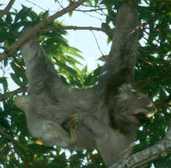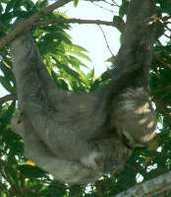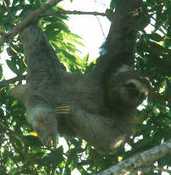
September 2000
The Brown-throated 3-toed Sloth is the most common and widespread of the family being found from Honduras to northern Argentina. They weigh over 4 kilos and are strictly tree dwellers descending to the ground only to defecate every 2 to 8 days. (Note that, while 2-toed sloths have 2 toes on their fore limbs they have 3 toes on their hind limbs.)
Their diet consists entirely of leaves so they are restricted to areas of evergreen (mainly Cecropia) forest.

For this reason they favour the crowns of trees that receive the sun so that, when resting, they can regulate their body heat by moving in and out of the sun.

Another of the results of their slow movement is that their backs are covered with algae. This is a symbiotic relationship since the algae flourish in the forest humidity while the sloth benefits from the camouflage that the algae provide. The sloth's fur is also home to small moths.
There is an illustration in Eisenberg, Plate 2.
There is further information and more photos at the following web sites:
The Sloth Website
The University of
Michigan
| Previous Page | Back to Index | Next Page |